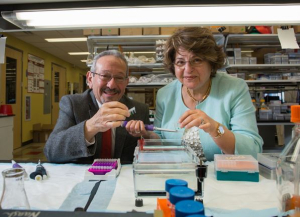Two Cullen College biomedical engineering professors, Muna Naash, John S. Dunn Endowed Professor and Muayyad Al-Ubaidi, see eye-to-eye on just about everything. Both are working to eradicate eye disease, both discovered Retbindin, a retina-specific protein, and together they have now received $1.1 million from the National Institutes of Health to explore the role of Retbindin in diseases.
But wait, there’s more. The pair of professors, hired at UH in 2015, has been married for over 40 years. They discovered each other the same way they discovered Retbindin. They weren’t looking, but there it was.
First, the story of science. Then the tale of chemistry.
Discovering Rtbdn
“It was what you might call serendipity,” says Naash who was leading a research group in 2014, investigating other retina-specific proteins, when they identified this new Retbindin, or Rtbdn for short.
Although the gene was known, no one had ever studied the protein, which is retina specific.
The couple began working on identifying its exact locations in the body, making antibodies to help pinpoint its whereabouts, eventually finding it only occurs in the retina at the interface between photoreceptors and retinal pigment epithelium (RPE) microvilli, a region critical for retinal function and stability.
A closer look
The pair conducted further work and proved that Rtbdn may be vital for keeping eyes healthy.
“We know that the amount of Rtbdn is changed as the retina becomes sick,” said Al-Ubaidi. “We also know that this protein is involved in the energy production in the retina and, of course, energy is the only way to keep tissue healthy and alive.”
Rtbdn is capable of binding with retinal flavins, a critical metabolic factor in keeping the retina healthy. Flavins are derived from riboflavin, a member of the vitamin B family. Rtbdn is also a potential carrier of flavins between the retina and the RPE.
In the retina, the levels of flavins are several folds higher than in blood. In fact, riboflavin deficiency results in photosensitivity and degeneration. But, unbound flavins are toxic so, in practice, flavins are virtually always bound to flavin-binding proteins.
“The study on flavins in the eyes has been forgotten since the 1940s and ‘50s,” said Naash.
Until now.
With the NIH funding, the pair will test the role Rtbdn plays in the development and progression of retinal degenerative diseases such as retinitis pigmentosa, which often leads to blindness. If, in fact, Rtbdn turns out to be beneficial, they could eventually provide it to a diseased retina as a cure.
In science, cures and breakthroughs like that often come in small steps. According to Al-Ubaidi, “We’re at the top of the first floor of a 20-story building.”
Love at first sight
Pace is often faster in the world of chemistry. For Naash, it was over the first time she saw Al-Ubaidi on the very first day of college at the University of Baghdad where they were both freshmen, majoring in biochemistry.
“I really noticed him the very first day because he was fluent in English, because he did all his high school studies in an American high school,” she said. “I was so impressed.” Naash said she shocked herself when she realized that she was immediately thinking, “That’s my man!”
She says it took him a couple more days to notice her when she began to speak up in class. “She was not passive or afraid and that was my idea of how women should be – that they should be equal to men,” he said.
Four decades, one son, two grandchildren, countless hours of work and major scientific discoveries later, their collaboration remains strong.
No wonder they study vision. They’ve had a very clear one since the day they met.
